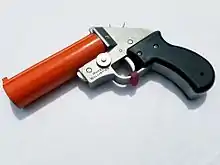

A flare gun, also known as a Very pistol or signal pistol, is a large-bore handgun that discharges flares, blanks and smoke. The flare gun is typically used to produce a distress signal.
Types
The most common type of flare gun is a Very (sometimes spelled Verey),[1] which was named after Edward Wilson Very (1847–1910), an American naval officer who developed and popularized a single-shot breech-loading snub-nosed pistol that fired flares (Very lights).[2] They have a single action trigger mechanism, hammer action, and a center fire pin.[3] Modern varieties are frequently made out of durable plastic of a bright colour that makes them more conspicuous and easier to retrieve in an emergency and assists in distinguishing them from conventional firearms.

The Very pistol, typical of the type used in the Second World War, are of one inch bore (26.5mm), now known as "Calibre 4" for signal pistols.[4] These are still available and more recent longer-barrel models can also fire parachute flares.[5] Many newer models fire smaller 12-gauge flares. In countries where possession of firearms is strictly controlled, such as the United Kingdom, the use of Very pistols as emergency equipment on boats is less common than, for example, the United States. In such locations, distress flares are more commonly fired from single-shot tube devices which are then disposed of after use. These devices are fired by twisting or striking a pad on one end, but the contents are otherwise similar to a round from a flare gun, although the flares themselves are much larger and can burn brighter for longer. In the Russian Federation, which also has strict controls on firearms, a special tube-shaped flare launching device called a "Hunter's Signal" (Сигнал Охотника) is available. This is reusable but is deliberately designed in a way to avoid resemblance to a gun.
Flare guns may be used whenever someone needs to send a distress signal. The flares must be shot directly above, making the signal visible for a longer period of time and revealing the position of whoever is in need of assistance. There are four distinct flare calibers: 12-gauge (18.53mm), 25mm, 26.5mm, and 37mm – the first three being the most popular for boaters.
Use as weapons

Flare guns may be used as effective incendiary weapons for the destruction of flammable material, or in an anti-personnel role.[6][7][8]
Pocket mortars
In World War II, Germany manufactured grenades designed to be fired from adapted flare guns known as the Kampfpistole, or Sturmpistole in its final form. Fragmentation and anti-tank grenades were produced, but the latter would likely have been of limited use against late-war armoured vehicles.[9]
The Soviets developed the Baranov pocket mortar during 1943, which fired a 175g round with an 8g explosive charge out to a range of 200-350m (it was also proposed to increase this to 600-700m).[10] A later development was the PSA/PSA-1/ASP, a copy of the US issue M8 flare pistol. This fired an experimental grenade which was 40% more powerful than that used with the Kampfpistole.
Conversion kits
Conversion kits are available intended to convert flare guns to accept conventional ammunition by use of barrel inserts. There are also 12 gauge inserts intended to allow use of rifle or pistol ammunition in conventional 12 gauge shotguns. Use of any of these devices in the Orion plastic 12 gauge flare gun is not recommended by the manufacturer and ATF tests have demonstrated that sometimes a single use results in a catastrophic failure. In the United States, if these conversion kits are used in a metal flare gun, the converted gun is considered to be a firearm by the ATF. If a rifled barrel insert is used, the converted firearm is classified as a pistol; if a smoothbore barrel insert is used, the converted firearm is classified as an AOW subject to the additional requirements of the NFA.[11] Flare cartridges are low pressure compared to conventional ammunition and even metal flare guns are not designed or intended to be used with conventional ammunition. Conversion of a flare gun to fire conventional ammunition may also be restricted by local improvised firearm laws.
See also
References
- ↑ Chambers 21st Century Dictionary (revised ed.). New Delhi: Allied Publishers (P) Ltd. 2005. p. 1578. ISBN 81-86062-26-2.
- ↑ McLain, Joseph Howard (1980). Pyrotechnics: from the viewpoint of solid state chemistry. Franklin Institute Press. p. 87. ISBN 9780891680321. Retrieved 4 January 2018 – via Google Books.
Another historically famous flare, still in use, is the Very light, invented by a U.S. naval officer, Edward W. Very (1874–1910). It is white or colored and is fired from a special pistol.
- ↑ Julio S. Guzmán, Las Armas Modernas de Infantería, Abril de 1953
- ↑ "Signal Pistol and Cartridges". Paines Wessex. Archived from the original on 2017-02-16. Retrieved 2016-07-28.
- ↑ Pains Wessex catalogue Archived 2013-01-11 at archive.today showing modern 26.5mm flare gun and both parachute flares (maroons) and conventional flare cartridges, accessed July 2012
- ↑ Cutlack, F. M. (1941). "Official History of Australia in the War of 1914–1918". The Australian Flying Corps in the Western and Eastern Theatres of War, 1914–1918 (11th online ed.). Canberra, ACT: Australian War Memorial. pp. 168–169.
- ↑ Falls, Cyril (1930). Military Operations Egypt & Palestine from June 1917 to the End of the War. Official History of the Great War Based on Official Documents by Direction of the Historical Section of the Committee of Imperial Defence. Vol. II. Part II. London: HMSO. p. 466. OCLC 256950972.
- ↑ "Pembrey Airport: History". Archived from the original on 2012-02-22. Retrieved 2008-11-09.
- ↑ "Kampfpistole". Archived from the original on 2023-10-21. Retrieved 2023-10-21.
- ↑ https://www.tankarchives.ca/2018/07/personal-artillery-for-downed-pilot.html
- ↑ "Flare Insert – Any Other Weapon" Archived 2017-04-27 at the Wayback Machine, ATF Firearms Technology Branch, May 4, 2006.
Further reading
- Bonnier Corporation (November 1942). "Firing Very Pistol". Popular Science. Bonnier Corporation. p. 126.
External links
- History of the Very pistol with many examples
- WW German signal-pistol grenades and their use by tank crews.